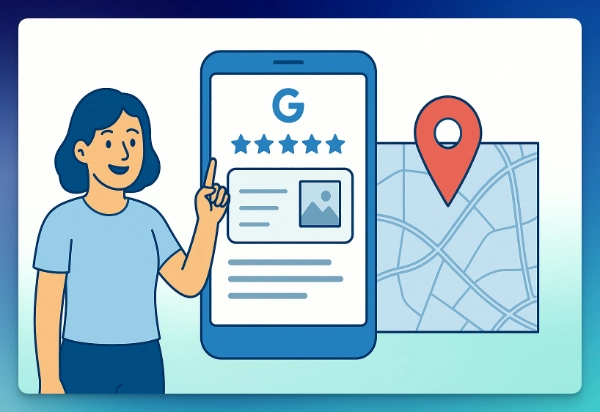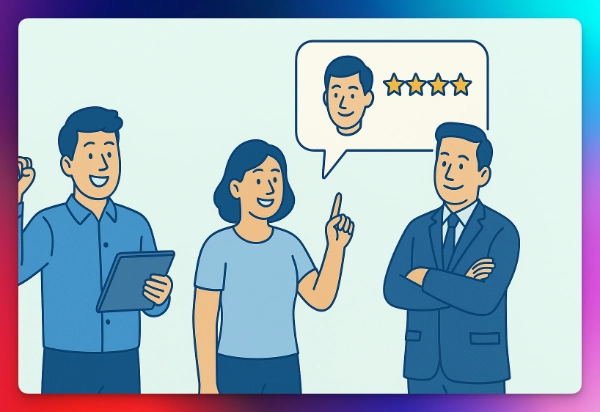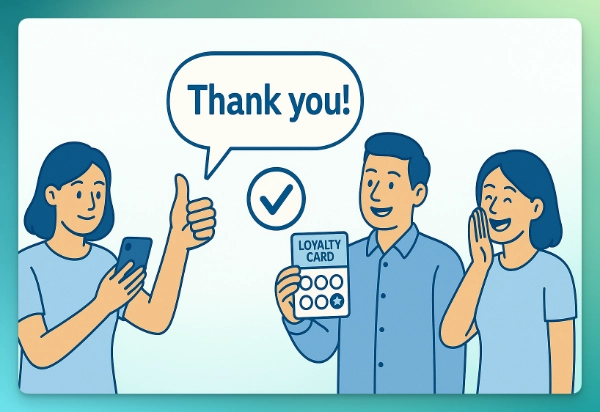How to Grow a Small Business:
The Best Improvement Strategy for Sustainable Growth

This guide gives local owners a clear path to business growth with practical steps you can use this month. You’ll learn how to grow a small business sustainably by focusing on visibility, credibility, and retention.
Understand What Drives Small Business Growth
Small business growth is more than “more customers.” It’s building repeatable systems that earn attention, build trust, and create loyal return customers.
Visibility
Search, maps, and local listings.
Credibility
Reviews, real photos, clean site.
Retention
Follow up and reward loyalty.
Why this works
The three pillars compound into sustainable business growth.
Step 1: Build Local Visibility
Local visibility is what helps people in your area actually find you. When someone searches “dentist near me” or “best barbershop in Henderson,” Google decides which local businesses appear first. Winning that placement starts with a strong foundation.
Optimize Your Google Business Profile
Think of your profile as your online storefront. It’s the first impression most new customers see. An accurate, complete profile signals credibility and boosts your ranking in map searches.
- Accurate NAP: make sure your Name, Address, Phone match exactly across your site and listings.
- Update business hours, services, and upload 8–10 high-quality real photos of your space and staff.
- Use location-based phrases naturally (e.g., “family dentist in Spring Valley”).
- Ask satisfied clients for reviews and always reply — it shows engagement.

Strengthen Your Local SEO
Local SEO helps search engines understand where you operate and who you serve. It’s how your website and listings work together to bring foot traffic and calls.
- Add your city or ZIP code to title tags, headings, and meta descriptions.
- Include a Google Map embed and directions section on your contact page.
- Implement Local Business Schema markup so Google can verify your details.
- Ensure your site is mobile-friendly and loads fast — over 60% of local searches happen on phones.
- Compress large images to improve speed and SEO scores.
- Keep listings consistent on Apple Maps, Bing Places, Yelp, and Nextdoor.
Mastering local visibility is foundational to sustainable business growth.
Step 2: Level Up Credibility
Visibility gets attention, but credibility earns trust. When customers compare local businesses, they pick the one that looks reliable, transparent, and human. Building credibility is about proof — showing real people, real feedback, and a professional experience.

Reviews & Testimonials
People trust people — not ads. A few genuine reviews carry more weight than any promotion. Reviews help Google rank you higher and reassure hesitant customers that you deliver what you promise.
- Ask every happy client for a short review right after the service.
- Reply to both positive and negative feedback — it shows you care.
- Feature 3–5 rotating testimonials on your homepage and service pages.
- Include star ratings in your search results using simple schema markup.
Real Visuals Build Real Trust
Stock photos make a business feel distant. Customers connect better when they see your real space, real staff, and real results. Authentic images tell a story that generic branding never can.
- Show your workspace, front desk, and team members doing actual work.
- Use consistent lighting and colors that match your brand palette.
- Post short 10–20 second clips of your process or customer smiles (with permission).
- Refresh visuals every few months to show your business is active.
Professional Website Experience
Your website is often your first impression. It should feel fast, trustworthy, and simple — not flashy or cluttered. A slow or outdated site tells visitors your business isn’t current.
- Make sure your site loads in under 3 seconds on mobile.
- Use clear navigation and short headings that guide visitors to book or call.
- Ensure phone numbers are clickable and contact forms actually work.
- Keep fonts, colors, and spacing consistent — a tidy design signals professionalism.
- Include SSL (https://) and visible privacy details to boost trust.
Step 3: Engage Your Community
Show up where your customers live, work, and scroll. Community presence builds trust faster than ads and turns first-time visitors into loyal regulars.
Sponsor School Teams or Local Causes
Pick causes your customers already care about. Keep it simple and visible.
- Provide snacks, water, or uniforms with a small logo (clean, not loud).
- Host a “give-back day” (e.g., 5% of sales to the PTA or a youth league).
- Create a one-page flyer with a QR code to your booking/offer page.
- Post recap photos and thank-yous; tag the school or nonprofit.
Offer Teacher, First Responder, & Student Discounts
Make the offer clear, easy to redeem, and limited to specific days/times if needed.
- Simple structure: 10–15% off with valid ID (Mon–Thu).
- Create a short landing page explaining who qualifies and how to redeem.
- Print a countertop card and add the offer to Google Business “Updates.”
- Collect quick testimonials from beneficiaries (with permission).
Cross-Promote with Nearby Businesses
Partner with non-competing neighbors to trade audiences and reduce ad spend.
- Bundle offers (e.g., “Haircut + Coffee” or “Cleaning + Whitening kit”).
- Swap flyer space by each register and add each other to confirmation emails.
- Co-host a mini event (demo, Q&A, live music) and split promo duties.
- Share a simple UTM link for each partner to track referrals.
Cadence & Measurement
- Weekly: 1 community post + 1 outreach message.
- Monthly: 1 partner promo or give-back action.
- Track: redemptions, referral source, new reviews, and email signups.

Stronger community ties accelerate small business growth in every neighborhood.
Step 5: Launch a Simple Referral Program
Word-of-mouth is still the most powerful form of marketing — and referral programs are how you scale it without expensive ads. People trust recommendations from friends and family far more than anything they see online. The goal here is to make sharing your business effortless and rewarding.
Create a Win–Win Offer
The best referral programs reward both sides — the person referring and the new customer. Keep the reward simple, valuable, and easy to explain in one sentence.
- Example 1: $25 off for both when a friend books a service.
- Example 2: Free upgrade, add-on, or small gift for each referral.
- Example 3: A points system (e.g., refer 3 people, get one free visit).
- Display the offer on receipts, emails, and at checkout.
Make It Easy to Share
Your referral system should take no more than 10 seconds for a customer to use. The fewer steps, the more likely they’ll share.
- Add a QR code on your counter, receipts, and business cards.
- Include a “Refer a Friend” button on your website or booking page.
- Send a follow-up text or email with a shareable referral link.
- Encourage staff to mention it after each positive visit.
Promote It Everywhere
People can’t join a program they don’t know about. Treat your referral offer like a mini-campaign — keep it visible and remind customers often.
- Pin the offer to your social media profiles and Google Business posts.
- Highlight it in your email signature and monthly newsletters.
- Print a small sign or window decal near your entrance.
- Record a 15-second video explaining how it works and post it monthly.
Track and Reward Consistently
Tracking helps you see what works and ensures your best advocates feel appreciated. Recognition is often more motivating than the reward itself.
- Review referrals monthly — who sent the most, how many converted.
- Publicly thank top referrers (social post, email, or in-person shoutout).
- Offer a “Top Referrer of the Month” perk (gift card, free service, or merch).
- Track results in a simple spreadsheet or CRM tag (Referrer: [Name]).
Keep It Fresh
Even the best offers lose steam if they never change. Refresh your referral program every few months with new incentives or small twists to keep people engaged.
- Rotate between dollar discounts, freebies, and exclusive invites.
- Make seasonal themes (e.g., “Spring Referral Bonus” or “Holiday Giveaway”).
- Run a short 30-day challenge: “Refer 2 friends this month and win.”
Step 6: Retain Customers with Follow-Up
Getting a new customer is great — keeping them is where real profit lives. Customer retention costs far less than new acquisition, and loyal customers often spend more, visit more often, and send more referrals. Follow-up isn’t about sales pressure; it’s about care, connection, and consistency.
Send a Thank-You Within 24 Hours
A quick thank-you message makes customers feel remembered and valued. It turns a simple transaction into a relationship. The first 24 hours after a visit is the best time to reinforce trust and invite them back.
- Send a short text or email: “Thanks for visiting! We appreciate your business.”
- Add a soft nudge: “If you enjoyed your visit, we’d love a quick review on Google.”
- Include a friendly reminder of your next available appointment or special offer.
- Use automation tools (e.g., Square, HubSpot, or Zapier) to send messages automatically.
Build Loyalty Through Small Rewards
Loyalty programs don’t have to be fancy — just meaningful. Even small perks make repeat customers feel recognized and appreciated.
- Offer a freebie or discount after every 3–5 visits.
- Use punch cards, QR-based tracking, or a simple digital loyalty system.
- Surprise loyal customers occasionally with a small gift or thank-you note.
- Promote your loyalty rewards in-store, on social media, and via email.

Ask for Feedback & Fix Friction Fast
Every piece of feedback is an opportunity. When you invite honest opinions and take quick action, customers see that you care and are willing to improve. Even a negative review handled gracefully can turn into a long-term loyal customer.
- Send short surveys via email or text after key visits (e.g., “How was your experience today?”).
- Monitor Google, Yelp, and social media for mentions — respond kindly and promptly.
- Fix recurring issues within a week and let customers know when you’ve made improvements.
- Keep a simple feedback log to spot patterns and make proactive changes.
Stay in Touch Without Spamming
Consistent communication keeps your business top of mind, but overdoing it drives people away. Aim for meaningful, occasional contact — not constant noise.
- Send a monthly newsletter with updates, helpful tips, and special offers.
- Celebrate customer birthdays or anniversaries with a discount or message.
- Send seasonal “We’re thinking of you” emails (holidays, school seasons, etc.).
- Keep messages short, friendly, and relevant — always add value.
Measure Retention Over Time
You can’t improve what you don’t measure. Tracking simple retention metrics shows whether your follow-ups and loyalty programs are working.
- Repeat Visit Rate: what percentage of customers come back within 3 months?
- Referral Rate: how many new customers come from existing ones?
- Churn: how many customers haven’t returned in 6+ months?
- Adjust your communication rhythm based on these trends.
Step 7: How to Set Up Your Business Growth Plan (30 Days)
Growth doesn’t happen by luck — it happens by rhythm. This 4-week plan gives you small, focused wins each week so your business grows naturally without overwhelm. Follow it once a month, repeat it quarterly, and refine as you go.
This 30-day system shows how to set up your business growth plan with practical weekly steps you can repeat.
Week 1 — Foundation
Set your digital base so people can find and trust your business instantly.
- Polish your Google Business Profile; add 10+ real photos.
- Claim and sync listings on Apple Maps, Bing, and Yelp.
- Update page titles and H1s with city/ZIP + service.
Week 2 — Local Presence
Get your first wave of social proof and connect with your neighborhood online.
- Collect your first 5–10 Google reviews.
- Introduce your business in local Facebook or Nextdoor groups.
- Distribute QR cards linking to your booking or contact page.
Week 3 — Social & Ads
Build awareness and repetition — the two keys to staying top-of-mind locally.
- Post 3–4× per week (tips, testimonials, or behind-the-scenes).
- Run a $5–$10/day geo-targeted ad for brand familiarity.
- Record a short 30–45s intro video and pin it to your socials.
Week 4 — Referrals & Retention
Turn happy customers into repeat visitors and promoters for your brand.
- Launch a simple referral offer online and in-store.
- Send follow-ups thanking customers and asking for feedback or reviews.
- Review your metrics — see what worked and double down next month.
Pro Tip:
Print this plan as a checklist or make a Notion/ClickUp board for it. Each week’s consistency compounds — by the end of 90 days, your business will feel completely different.
The Best Improvement Strategy for Small Business Growth
There’s no secret hack — the best improvement strategy is steady execution. Repeat small, smart actions every month and your small business growth compounds.
How to Stay Consistent
- Schedule it:
block weekly time for reviews, posts, and follow-ups. - Keep it simple:
track in a Sheet or Trello—consistency > complexity. - Batch work:
draft posts/emails in one session, schedule ahead. - Track monthly:
log leads, reviews, calls; watch small wins add up. - Automate:
use schedulers and reminder tools for nudges. - Be patient:
momentum builds after steady weeks, not days.
Weekly Rhythm
- MonMondayplan posts + offers
(20m) - TueTuesdayask for reviews
(10m) - WedWednesdaypost tips / before–after
(15m) - ThuThursdayfollow-ups to new customers
(15m) - FriFridaycheck metrics + tweak ads
(20m)
Small Business Growth FAQs
How to grow a small business on a tight budget?
Focus on reviews, local listings, and weekly content. These low-cost plays compound small business growth.
What’s the best improvement strategy for local service brands?
Consistency. A simple 30-day loop is the best improvement strategy for reliable business growth.
How to set up your business growth plan in 30 days?
Use Step 7 to set up your business growth plan: visibility (week 1), reviews (week 2), awareness (week 3), referrals/retention (week 4).

Step 4: Create Social Proof Online
Social proof is the modern version of word-of-mouth. People don’t just trust your ads—they trust what others say about you online. Every post, review, and tagged photo becomes proof that your business delivers real value. This section focuses on how to use content and light advertising to build that trust.
Post Useful, Local Content
Instead of only promoting services, share practical, helpful, or entertaining posts that make locals stop scrolling. When people learn from you, they remember your name.
Use Low-Budget Local Ads
You don’t need a big budget to reach local customers. A small daily spend builds familiarity, keeps your brand visible, and reminds people you exist when they’re ready to buy.
Encourage User-Generated Content
When real customers post about you, it’s the strongest form of credibility. User-generated content (UGC) humanizes your brand and expands your reach without extra cost.
Measure & Refine
Treat your social proof like a living system. The goal isn’t vanity metrics—it’s to build recognition and steady trust over time.
Consistent social proof compounds trust and drives measurable business growth.